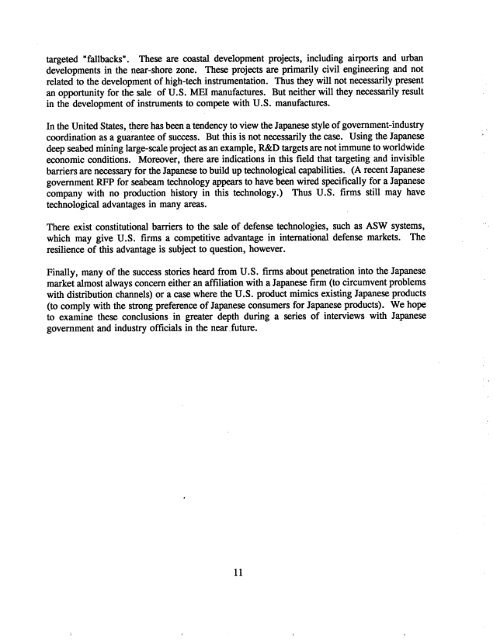WHOI-90-52
WHOI-90-52
WHOI-90-52
You also want an ePaper? Increase the reach of your titles
YUMPU automatically turns print PDFs into web optimized ePapers that Google loves.
tageted "fallbacks". These are coasta development projects, including airprts and urban<br />
developments in the nea-shore zone. These projects are primarly civil engineering and not<br />
related to the development of high-tech instrmentation. Thus they wil not necssaly present<br />
an opportunity for the sae of U.S. MEI manufactures. But neither wil they necssaly result<br />
in the development of instruments to compete with U.S. manufactures.<br />
In the Unite States, there has been a tendency to view the Japanese style of government-industr<br />
coordination as a guarantee of succss. But this is not necssaly the case. Using the Japanese<br />
deep sebed mining large-sce project as an example, R&D tagets are not immune to worldwide<br />
economic conditions. Moreover, there are indications in this field that tageting and invisible<br />
barers are necssa for the Japanese to build up tehnologica capabilties. (A recnt Japanese<br />
government RFP for sebeam tehnology appes to have been wired speificaly for a Japanese<br />
company with no production history in this technology.) Thus U.S. firms still may have<br />
technologica advantages in many areas.<br />
There exist constitutional barers to the sae of defense technologies, such as ASW systems,<br />
which may give U.S. firms a competitive advantage in international defense markets. The<br />
resilence of this advantage is subject to question, however.<br />
Finally, many of the success stories head from U.S. firms about penetration into the Japanese<br />
market almost always concern either an affiliation with a Japanese firm (to circumvent problems<br />
with distrbution channels) or a case where the U.S. product mimics existing Japanese products<br />
(to comply with the strong preference of Japanese consumers for Japanese products). We hope<br />
to examine these conclusions in greater depth during a series of interviews with Japanese<br />
government and industry officials in the nea .future.<br />
11
















